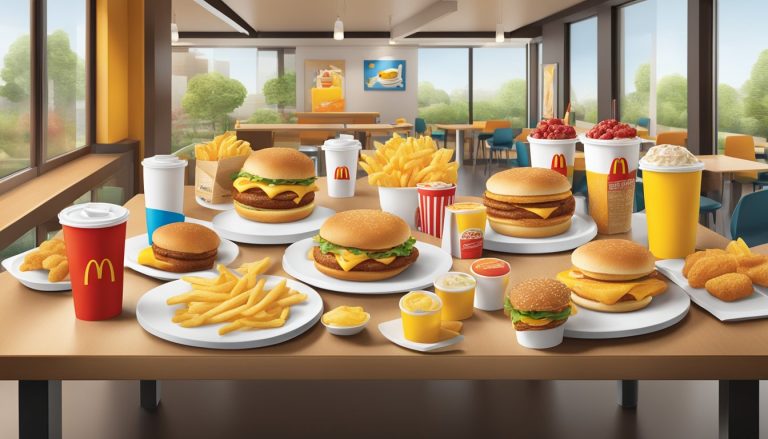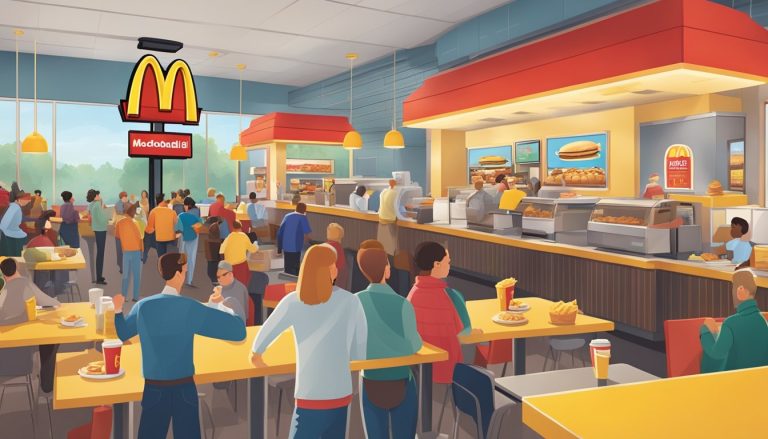McDonald’s breakfast menu has become a cultural phenomenon, captivating millions of customers worldwide. The fast-food giant’s marketing strategies for its morning offerings tap into deep psychological triggers, driving consumer behavior and loyalty.
McDonald’s breakfast marketing leverages psychological principles like convenience, familiarity, and nostalgia to create a powerful emotional connection with customers. By offering a quick and satisfying morning meal, McDonald’s has positioned itself as an integral part of many people’s daily routines.
The company’s breakfast campaigns often focus on the comforting aspects of their menu items, evoking memories of home-cooked meals while providing the speed and consistency that modern lifestyles demand. This clever blend of emotional appeal and practical benefits has helped McDonald’s dominate the fast-food breakfast market and cement its place in popular culture.
Evolution of McDonald’s Breakfast
McDonald’s breakfast has transformed from a simple morning offering to a global phenomenon. The journey spans decades, marked by innovative menu items and strategic shifts in availability.
Historical Context and the McDonald Brothers
In 1940, Richard and Maurice McDonald opened their first restaurant in San Bernardino, California. The original menu focused on barbecue items and did not include breakfast. As the business grew, the brothers streamlined their menu to focus on burgers, fries, and milkshakes.
This efficient “Speedee Service System” laid the foundation for modern fast food. However, breakfast was not yet part of the McDonald’s story. The concept of fast-food breakfast was still years away from becoming a reality.
Birth of the Egg McMuffin
The Egg McMuffin, introduced in 1972, revolutionized fast-food breakfast. Created by franchisee Herb Peterson, it was inspired by eggs Benedict. Peterson designed a special ring to cook perfectly round eggs, paired with Canadian bacon and cheese on an English muffin.
This innovative sandwich quickly gained popularity. It addressed the growing demand for quick, portable breakfast options. The success of the Egg McMuffin led to the development of a full breakfast menu, launched nationwide in 1977.
Other items like hotcakes, hash browns, and breakfast burritos soon followed. These additions cemented McDonald’s position as a breakfast destination.
All-Day Breakfast Expansion
In 2015, McDonald’s made a bold move by introducing all-day breakfast. This decision came after years of customer requests and careful market analysis. The expansion allowed customers to enjoy breakfast items beyond traditional morning hours.
Initially, the all-day menu included a limited selection of popular items like the Egg McMuffin and hash browns. The move boosted sales and attracted new customers, particularly millennials.
However, the implementation posed operational challenges. Kitchens had to be reconfigured to handle breakfast and regular menu items simultaneously. Despite these hurdles, all-day breakfast proved successful in revitalizing the McDonald’s brand and adapting to changing consumer preferences.
Understanding McDonald’s Marketing Strategies

McDonald’s has developed sophisticated marketing strategies to maintain its position as a global fast-food leader. The company leverages branding, product innovation, and targeted promotions to capture consumer attention and drive sales.
Branding Techniques and the Golden Arches
The Golden Arches logo is a cornerstone of McDonald’s branding strategy. This iconic symbol is recognized worldwide and evokes instant brand familiarity. McDonald’s uses consistent color schemes and design elements across its restaurants, packaging, and advertising to reinforce brand identity.
The company’s branding extends to its slogans, with memorable phrases like “I’m lovin’ it” becoming part of popular culture. McDonald’s also employs mascots such as Ronald McDonald to create emotional connections with customers, especially children.
Brand partnerships with popular movies and sports events further enhance McDonald’s visibility and appeal to diverse audiences.
Product Innovation and Menu Options
McDonald’s regularly introduces new menu items to stay relevant and cater to changing consumer preferences. The company invests in research and development to create products that balance taste, convenience, and perceived healthiness.
Recent innovations include:
- All-day breakfast options
- Premium burger lines
- Plant-based alternatives
McDonald’s adapts its menu to local tastes in different countries, offering items like the Teriyaki McBurger in Japan or the McAloo Tikki in India. This localization strategy helps the brand resonate with diverse cultural palates.
The company also focuses on improving existing products, such as removing artificial preservatives from classic menu items to appeal to health-conscious consumers.
Promotional Activities and Limited-Time Offers
McDonald’s uses a mix of promotional tactics to drive customer engagement and sales. Limited-time offers create a sense of urgency and excitement among consumers. The McRib sandwich, available only periodically, has developed a cult following due to its scarcity.
Seasonal promotions, such as the Shamrock Shake during St. Patrick’s Day, tie products to specific events or holidays. McDonald’s also leverages digital marketing through its mobile app, offering exclusive deals and a loyalty program to frequent customers.
The company participates in cause-related marketing, supporting initiatives like Ronald McDonald House Charities. This approach helps build goodwill and strengthens the brand’s image as a socially responsible corporation.
Consumer Behavior and Target Audience Analysis
McDonald’s breakfast marketing taps into key consumer motivations and preferences. The fast food giant tailors strategies to reach specific audience segments through social media, health-focused options, and emotional branding.
Social Media Impact on Consumer Preferences
McDonald’s leverages social media platforms to shape consumer behavior around breakfast choices. Instagram and TikTok campaigns showcase visually appealing breakfast items, driving engagement and desire. User-generated content featuring McDonald’s breakfast creates social proof and influences peer groups.
The company uses targeted ads and influencer partnerships to reach Millennial and Gen Z audiences. These demographics respond strongly to convenience-focused messaging about grabbing breakfast on-the-go. McDonald’s also taps into FOMO (fear of missing out) with limited-time breakfast offers promoted heavily on social channels.
Data analytics from social media interactions help McDonald’s refine menu items and marketing approaches in real-time. This allows the company to stay agile and responsive to shifting consumer tastes and trends.
Adapting to Health-Conscious Consumer Trends
McDonald’s has evolved its breakfast menu to cater to health-conscious consumers. The introduction of items like fruit and maple oatmeal, egg white options, and whole grain muffins reflects changing nutritional priorities.
Marketing emphasizes fresh ingredients and protein content to appeal to fitness-minded customers. Calorie counts and nutritional information are prominently displayed, providing transparency for health-aware consumers.
The company has also expanded plant-based and vegetarian breakfast choices in response to growing demand. These options are marketed as both environmentally friendly and nutritious alternatives.
McDonald’s uses subtle visual cues in advertising to reinforce the perception of healthier breakfast offerings. Images of active lifestyles and fresh produce are frequently paired with breakfast items to create positive associations.
Buying Behaviour and Emotional Connection
McDonald’s breakfast marketing aims to create emotional connections that drive repeat purchasing behavior. Nostalgia plays a key role, with campaigns often evoking childhood memories of weekend family breakfasts.
The company taps into the comfort food aspect of breakfast, positioning its menu as a reliable mood-booster to start the day. Marketing messages emphasize the ritual and routine of grabbing McDonald’s breakfast, building habitual buying patterns.
Sensory cues like the aroma of coffee and sizzling bacon are highlighted in ads to trigger cravings and impulse purchases. McDonald’s also uses cheerful, energetic imagery to associate its breakfast with positive emotions and productivity.
Limited-time offers and exclusive breakfast items create a sense of urgency and scarcity, prompting consumers to act quickly on their purchasing desires.
The Role of McDonald’s Franchise in Marketing

McDonald’s franchises play a crucial role in executing and adapting the company’s marketing strategies at the local level. They bridge the gap between global branding and regional preferences, while fostering strong community ties.
Local Tastes and Localized Marketing
Franchisees tailor McDonald’s menu to suit local palates. In India, the McAloo Tikki burger caters to vegetarian preferences. Japanese locations offer Teriyaki McBurgers. These adaptations reflect cultural sensitivities and regional flavors.
Franchises also customize promotional campaigns. They may highlight region-specific products or create special offers during local festivals. This approach helps McDonald’s resonate with diverse customer bases across different markets.
Franchisees leverage their community knowledge to implement targeted advertising. They choose optimal local media channels and adjust messaging to align with regional dialects or cultural nuances.
Franchise Support and Community Engagement
McDonald’s provides extensive marketing support to its franchisees. This includes access to national advertising campaigns, promotional materials, and social media guidelines. Franchisees can tap into these resources while adding their local touch.
Community engagement is a key focus for McDonald’s franchises. Many participate in local events, sponsor youth sports teams, or support nearby schools. These activities build goodwill and strengthen the brand’s local presence.
Franchises often collaborate with local charities or organize fundraisers. Such initiatives demonstrate social responsibility and deepen community connections. This grassroots approach complements McDonald’s broader marketing efforts, creating a more personalized brand experience.
Digital Evolution in Customer Engagement

McDonald’s has embraced digital technologies to transform how customers interact with the brand. This shift has revolutionized ordering processes and in-restaurant experiences.
Mobile Ordering and Customer Experience
McDonald’s mobile app allows customers to browse menus, place orders, and pay seamlessly. Users can customize meals, save favorites, and access exclusive deals. The app uses geolocation to notify nearby restaurants when a customer is approaching to pick up their order.
Curbside pickup and restaurant check-in options provide added convenience. Real-time order tracking keeps customers informed throughout the process. The app also integrates with McDonald’s loyalty program, rewarding frequent customers with points and personalized offers.
Digital Displays and Self-Service Ordering
In-restaurant digital kiosks give customers control over their ordering experience. Large touchscreens display menu items with high-quality images and nutritional information. Customers can take their time browsing options and customizing orders without feeling rushed.
Self-service kiosks reduce wait times and improve order accuracy. They free up staff to focus on food preparation and customer service. Digital menu boards behind the counter dynamically update with new items, promotions, and pricing.
These technologies provide valuable data on customer preferences and ordering patterns. McDonald’s uses these insights to refine menu offerings and marketing strategies.
Brand Positioning and Customer Perception
McDonald’s breakfast marketing strategy centers on carefully crafted brand positioning and customer perception. The company aims to create a strong emotional connection with consumers while emphasizing convenience, value, and quality.
Brand Loyalty and Customer Retention
McDonald’s fosters brand loyalty through consistent messaging and familiar menu offerings. The company’s breakfast items, like the Egg McMuffin, have become iconic staples. This familiarity builds trust and encourages repeat visits.
McDonald’s loyalty program rewards frequent customers with points and exclusive offers. This incentivizes return visits and increases customer lifetime value.
The chain also leverages nostalgia in its marketing, reminding customers of positive childhood memories associated with McDonald’s breakfasts. This emotional appeal strengthens brand affinity and customer retention.
Brand Identity and the Customer Experience
McDonald’s brand identity for breakfast emphasizes speed, convenience, and reliability. The company positions itself as the go-to option for busy morning commuters and families seeking a quick, tasty meal.
The restaurant design and employee uniforms reinforce this brand identity. Clean, efficient spaces and friendly staff contribute to a positive customer experience.
McDonald’s also adapts its breakfast menu to local tastes in different markets. This cultural sensitivity enhances the brand’s appeal and customer satisfaction globally.
Nutritional Information and Healthier Options
In response to growing health consciousness, McDonald’s has introduced more nutritious breakfast options. The menu now includes items like oatmeal, yogurt parfaits, and fruit smoothies.
The company prominently displays calorie information on menu boards. This transparency helps customers make informed choices and improves brand trust.
McDonald’s has also reformulated some classic breakfast items to reduce sodium and eliminate artificial preservatives. These changes aim to appeal to health-conscious consumers without sacrificing taste or brand identity.
Analyzing Marketing Campaigns and their Efficacy

McDonald’s breakfast marketing campaigns leverage psychological principles and strategic partnerships to drive customer engagement and market share. These efforts combine targeted advertising with cross-promotions to maximize reach and effectiveness.
Advertising Campaigns and Targeted Advertising
McDonald’s employs data-driven targeting to tailor breakfast advertisements to specific consumer segments. They use demographic information, location data, and browsing habits to deliver personalized messages across digital platforms.
One successful campaign highlighted the convenience of grabbing breakfast on-the-go, resonating with busy professionals. Another focused on the affordability of their breakfast menu, appealing to budget-conscious consumers.
The fast-food giant also utilizes sensory marketing tactics. A Netherlands campaign tapped into the power of smell, releasing coffee aromas near billboards to trigger cravings and boost sales.
Strategic Partnerships and Market Share
McDonald’s collaborates with popular brands to expand its breakfast market share. A partnership with Kellogg’s led to the creation of limited-time cereal-flavored menu items, attracting new customers.
The company also teams up with food delivery services to reach stay-at-home consumers. These partnerships have helped McDonald’s maintain its position as a leading breakfast destination.
Cross-promotions with coffee brands have strengthened McDonald’s morning offerings. By aligning with well-known coffee companies, they’ve enhanced their credibility in the breakfast space.
These strategic alliances allow McDonald’s to tap into new customer bases and reinforce its dominance in the competitive breakfast market.
Operational Excellence and Value Proposition

McDonald’s breakfast strategy leverages operational excellence and a strong value proposition to attract customers and drive profits. The company focuses on affordability, efficiency, and service innovations to maintain its market leadership.
Affordability and Value for the Customer
McDonald’s breakfast menu offers competitive pricing to appeal to budget-conscious consumers. The company uses a tiered pricing strategy, providing options at various price points. Value meals combine popular items at a discount, encouraging customers to purchase more.
McDonald’s also runs periodic promotions and limited-time offers to create excitement and perceived value. For example, the “2 for $4” breakfast sandwich deal attracts customers looking for a filling meal at a low price.
Menu engineering helps maximize profitability while maintaining affordability. High-margin items are strategically placed alongside value offerings to balance revenues.
Improving Profit Margins through Efficiency
Operational efficiency is crucial to McDonald’s success in the breakfast market. The company employs several tactics to boost profit margins:
- Standardized cooking processes
- Specialized equipment for fast preparation
- Bulk purchasing to reduce ingredient costs
- Optimized kitchen layouts for speed
- Cross-training employees for flexibility
These efforts result in faster service times and lower labor costs. McDonald’s also uses data analytics to forecast demand, reducing food waste and ensuring fresh products.
Customer Service and Table Service Innovations
McDonald’s has introduced service innovations to enhance the breakfast experience:
- Mobile ordering for quicker pickup
- Self-service kiosks to reduce wait times
- Table service in select locations
These changes aim to improve customer satisfaction and differentiate McDonald’s from competitors. The company has also invested in staff training to ensure consistent, friendly service across locations.
Digital menu boards allow for easy updates and personalized recommendations, potentially increasing average check sizes. McDonald’s loyalty program further incentivizes repeat visits and provides valuable customer data.
Future Outlook for McDonald’s Breakfast Marketing

McDonald’s breakfast marketing is poised for significant evolution in the coming years. The fast-food giant will likely focus on adapting to changing consumer preferences, embracing technological advancements, and refining its signature offerings.
Trends Shaping the Fast-Food Landscape
Health-conscious options are expected to play a larger role in McDonald’s breakfast menu. The company may introduce more plant-based items and lower-calorie choices to cater to diverse dietary needs. Customization will likely become a key feature, allowing customers to personalize their breakfast orders.
Sustainability initiatives could become more prominent in marketing campaigns. McDonald’s may highlight eco-friendly packaging and sourcing practices to appeal to environmentally aware consumers.
The global reach of McDonald’s will be leveraged to introduce region-specific breakfast items. This strategy aims to boost market share by catering to local tastes while maintaining brand consistency.
The Restaurant of the Future and Signature Ranges
McDonald’s “Restaurant of the Future” concept will likely extend to its breakfast offerings. This may include redesigned dining areas with more comfortable seating and modern aesthetics to enhance the morning dining experience.
The McCafe brand is expected to expand, potentially featuring exclusive breakfast items and premium coffee blends. This move could position McDonald’s as a stronger competitor in the coffee shop market.
Signature breakfast ranges may be developed to target specific demographics. For example, protein-rich options for fitness enthusiasts or kid-friendly meals for families could become part of the regular menu.
Leveraging Technology for the Ultimate Dining Experience
Mobile ordering and payment systems will likely become more sophisticated. McDonald’s may introduce features like predictive ordering based on customer habits and preferences.
Artificial intelligence could be used to optimize drive-thru experiences, reducing wait times during busy breakfast hours. Voice-activated ordering systems may be implemented to streamline the process further.
Augmented reality might be incorporated into the McDonald’s app, allowing customers to visualize menu items before ordering. This technology could also be used for interactive marketing campaigns to boost engagement.
Digital menu boards may offer personalized recommendations based on customer data, potentially increasing sales of breakfast combos and add-ons.




